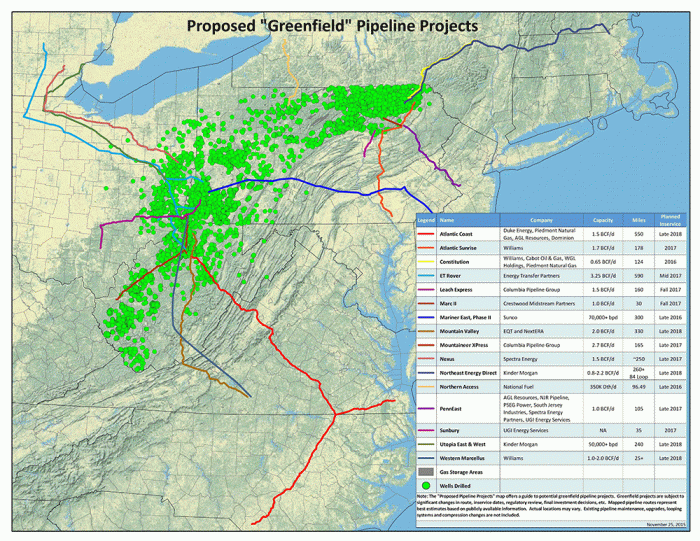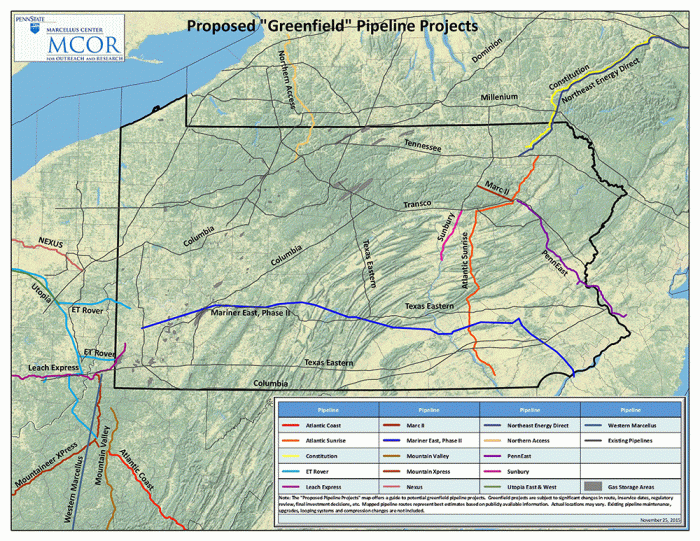Pipeline Basics
Natural gas pipelines crisscross the United States, moving over a quarter of the nation’s energy from the wellhead to market. With the increase in natural gas production in the US, there is a need to build more pipeline capacity to deliver this new supply to end users. As a result, communities throughout the country are experiencing an increased level of natural gas pipeline development. Currently, about 3,000 miles of interstate natural gas pipeline is being proposed in the Northeastern and Mid-Atlantic region in the US. Combined, these projects would have the ability to move about 18 billion cubic feet of natural gas per day plus 345,000 barrels per day of natural gas liquids (ethane, propane, and butane) out of the Appalachian basin. Most of these projects are expected to be completed and operational by 2020. The following video gives a brief overview of pipelines in the field.
Video: Gas pipeline right of way (1:14)
I'm standing in a pipeline right away. So beneath my feet, there's at least one gas line carrying gas away from the well pads that are up here on the mountain, and ultimately carrying it to a larger intrastate transmission line, which would carry the gas to the marketplace. So when we're talking about that pipeline, we're talking about a pipeline that might be three feet in diameter, a huge pipeline that can carry many tens of millions of cubic feet of gas per day. The reason you have this open area is so that roots don't interfere with the pipelines beneath me. Grasses would be okay, but you don't want to have tree roots that could interfere with the pipeline's integrity. Therefore, this area is kept clear of any trees. The fact that this area is kept free of trees though, can be an issue because what you're doing is creating a discontinuity in the forest, and so some of the smaller species, imagine a turtle trying to get from this side to the other side of this clearing, might have a hard time on a hot day like this. However, it also creates feeding opportunities and grazing opportunities for animals like turkey and deer. We actually just saw a deer standing behind us here.
The maps below indicate the location of proposed ‘greenfield’ natural gas and natural gas liquid pipelines in the Eastern US. ‘Greenfield’ refers to new pipeline being proposed in newly acquired right-of-ways, as opposed to pipeline upgrades or expansion of existing systems.


Pipelines are generally buried underground, although they may have associated surface facilities such as valves, metering stations, compressor stations, pig launchers, and pig receivers. In this case, a "pig" is a pipeline inspection gauge that travels through the pipeline to clean and check the integrity of the piping. When studying proposed pipeline projects, it’s important to understand the benefits and associated costs that pipelines represent as summarized below (Source: Penn State Extension)
| Natural Gas Pipeline Benefits | Potential Impacts from Pipelines |
|---|---|
| Safe, cost-effective transportation | Environmental impacts during construction and operation |
|
Energy and consumer products produced from natural gas
|
Safety and human health concerns |
| Nearly 100% of natural gas consumed in the US is transported via pipeline | Impairment of viewsheds and landscape |
| Negative impact on property values and future use of the land |